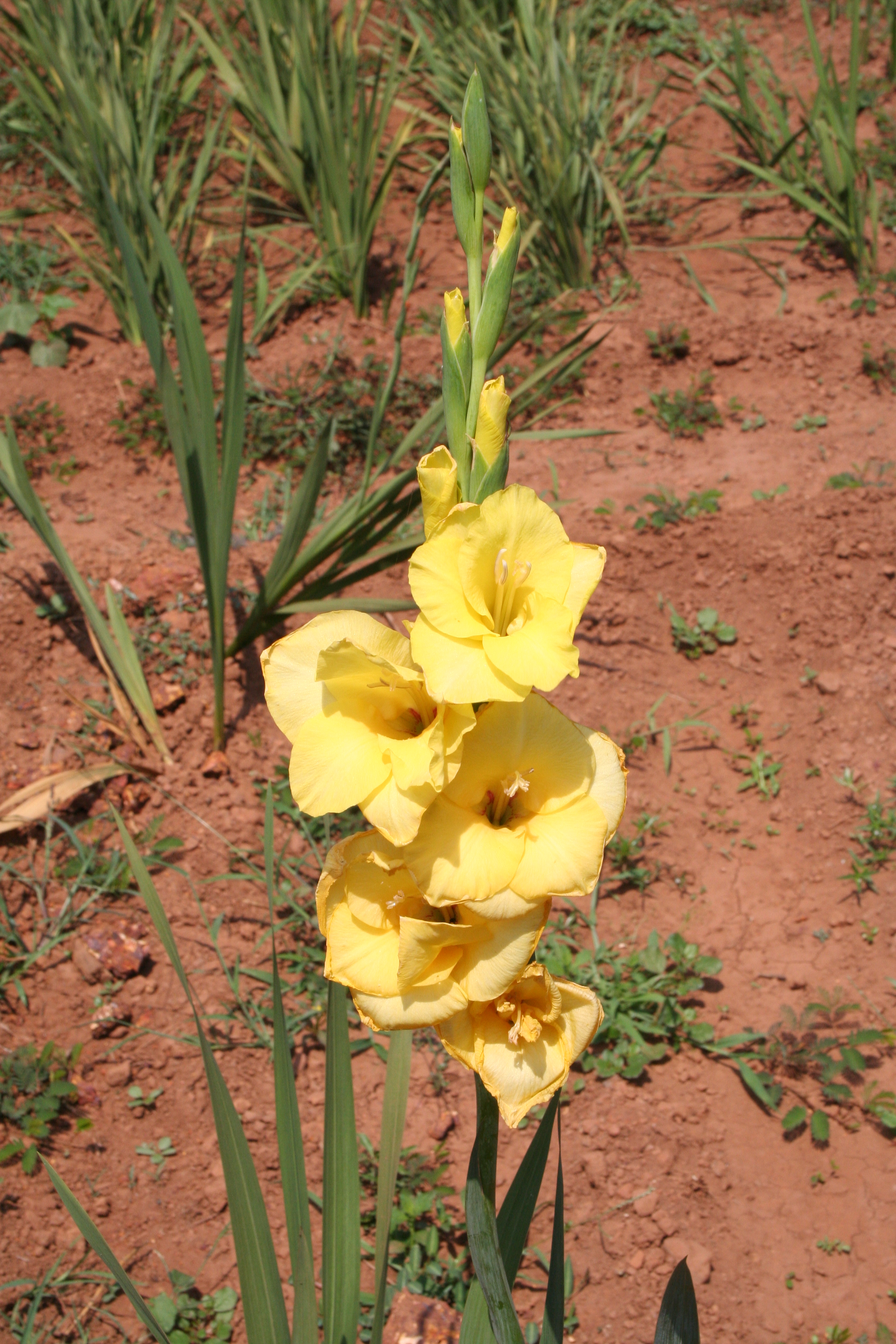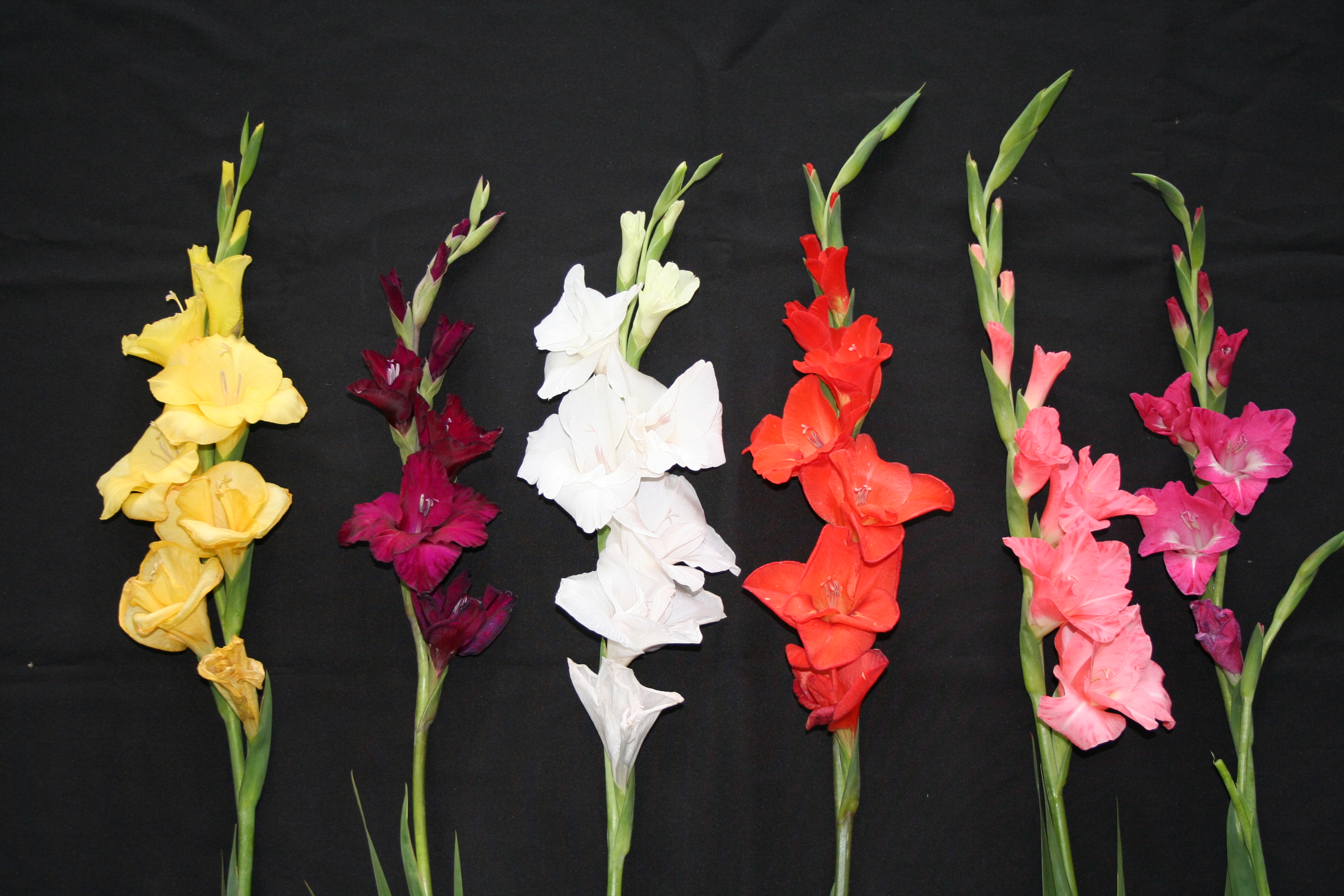
Crop: Gladiolus
Scientific name : Gladiolus sps- Iridaceace
Common / Local Name : Sword lily
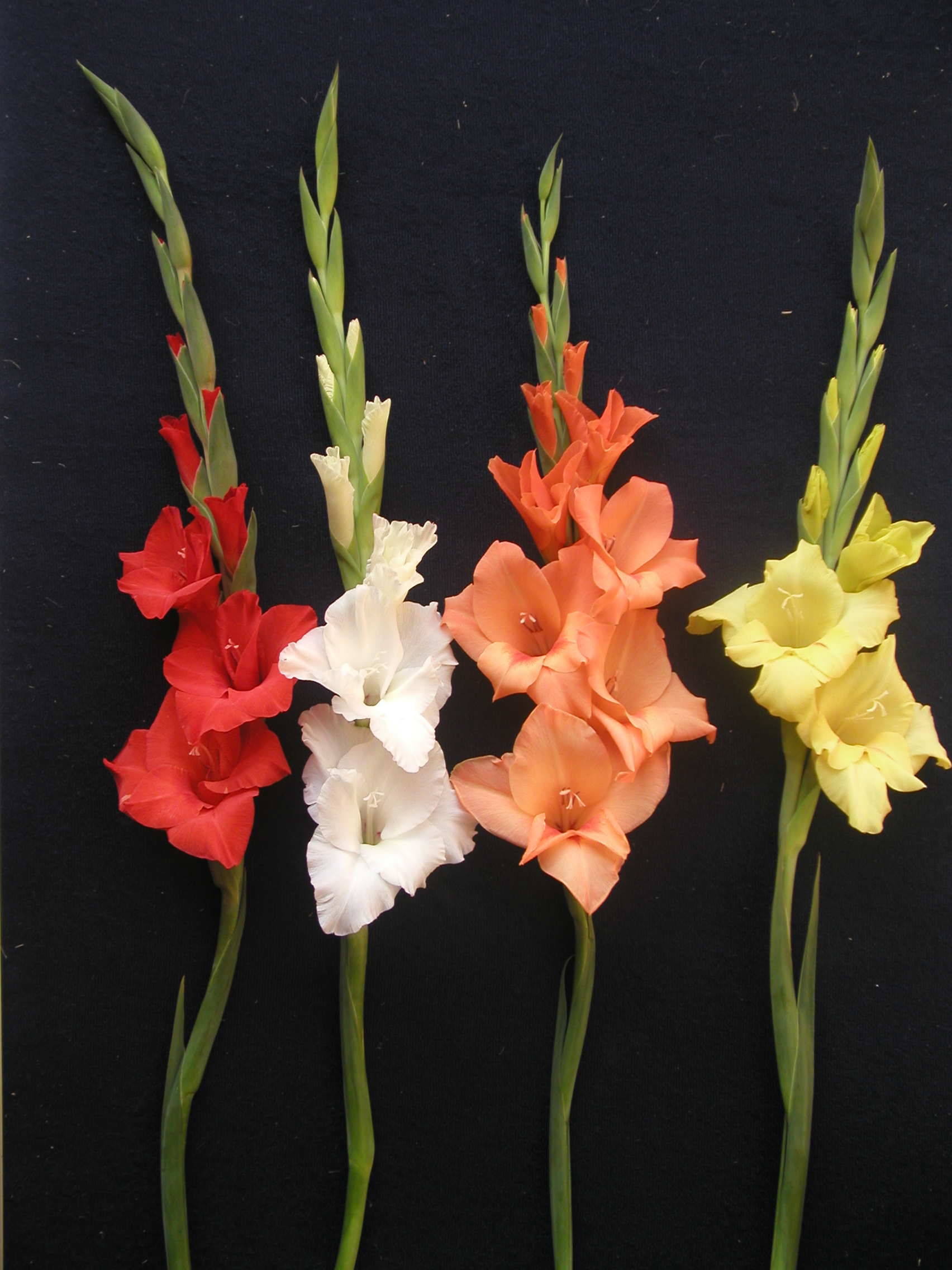
Gladiolus, popularly called sword lily, takes its name from the Latin word Gladius because of sword shaped leaves. It is one of the major cut flowers in national and international markets and it is grown commercially to an extent of 1500 ha in India. It is mainly cultivated in Karnataka, West Bengal, Maharashtra, Punjab, Haryana, Uttar Pradesh, Tamil Nadu, Jammu &Kashmir, Uttaranchal, Delhi, Sikkim and Himachal Pradesh. It’s elegant spikes with wide range of colours in various forms and size has won for it a place of pride in ornamental gardens and monetary value as a cut flower. It is widely used in flower arrangement, bouquets, bunches, baskets and indoor decorations.
Gladiolus requires good soil preparation for its better growth and yield. Land should be ploughed thoroughly at least a fortnight prior to planting of corms. Exposure of soil to the sun is required to kill weeds and insects. Ploughing, harrowing and leveling of land can be done with an interval of 7 days. Apply the recommended dose of manure prior to ploughing of soil. Open the furrows and ridges as per the spacing and make irrigation channels a day prior to the planting. Gladiolus does not need deep cultivation as it is a shallow rooted crop so the ploughing to a depth of 30 cm is sufficient.
Open furrows up to 15cm depth, plant corms in furrows and cover with soil to avoid an exposure to the sunlight. Care should be taken not to plant corms upside down. Planting can be done in furrows in all seasons. However, planting on ridges is better for water logged or ill drained areas because plants cannot tolerate water stagnation. Normally corms are planted at 15-25cm apart in a row and rows are spaced at 30-45 cm apart. Accordingly, the density of planting is varied from 1-1.5 lakh plants per hectare.
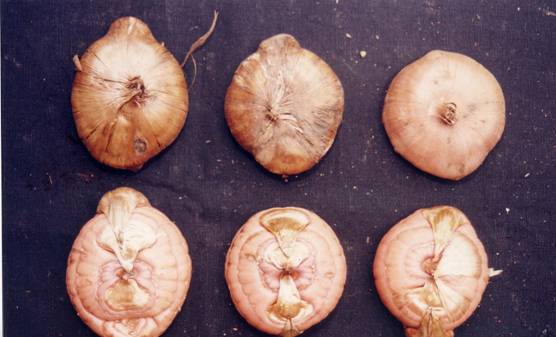
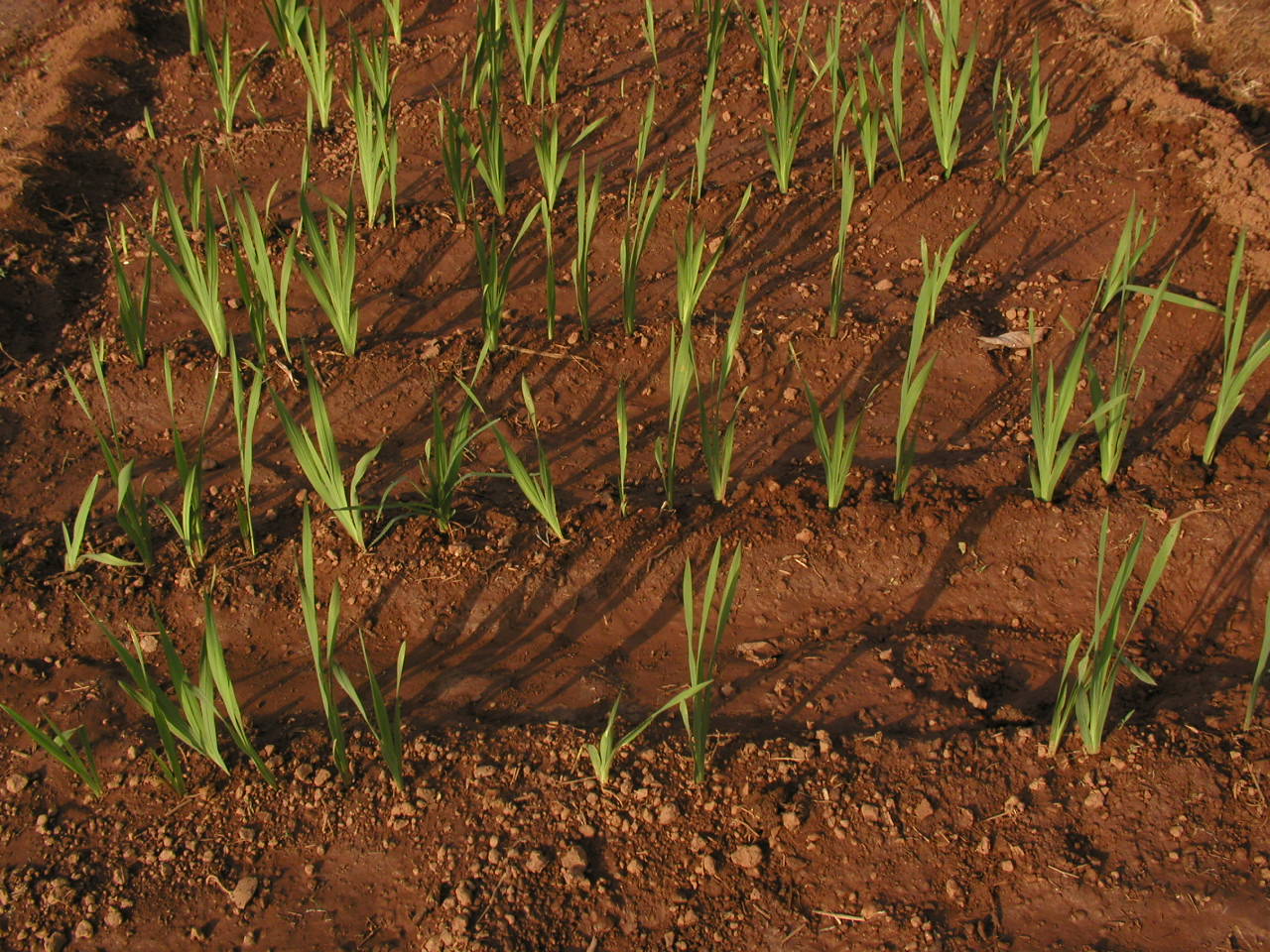
Performance of gladiolus varieties is not uniform under different agro-climatic conditions of India. There are some varieties which perform well in all locations and in all the seasons of particular location. So, location specific selection is very important aspect before going for commercial cultivation. There is a wide range of colours in gladiolus varieties. Colour and length of spike play a major role in gladiolus trade in Goa. The preferred colours are white, red, orange, pink, yellow and purple. American Beauty, Friendship, Her Majesty, Jester, Nova Lux, Royal Gold, Oscar, Morning Kiss, Day Dream, Priscilla, White Prosperity, White Friendship, Rose Supreme, Wigs Sensation, Eurovision, Mascagni, Blue Sky, Peter Pears, Rose Delight, Christian Jane, Sancerre, Yellow Stone, Trader Horn, Apollo, and Jack’s Gold are some of the varieties grown commercially in India.
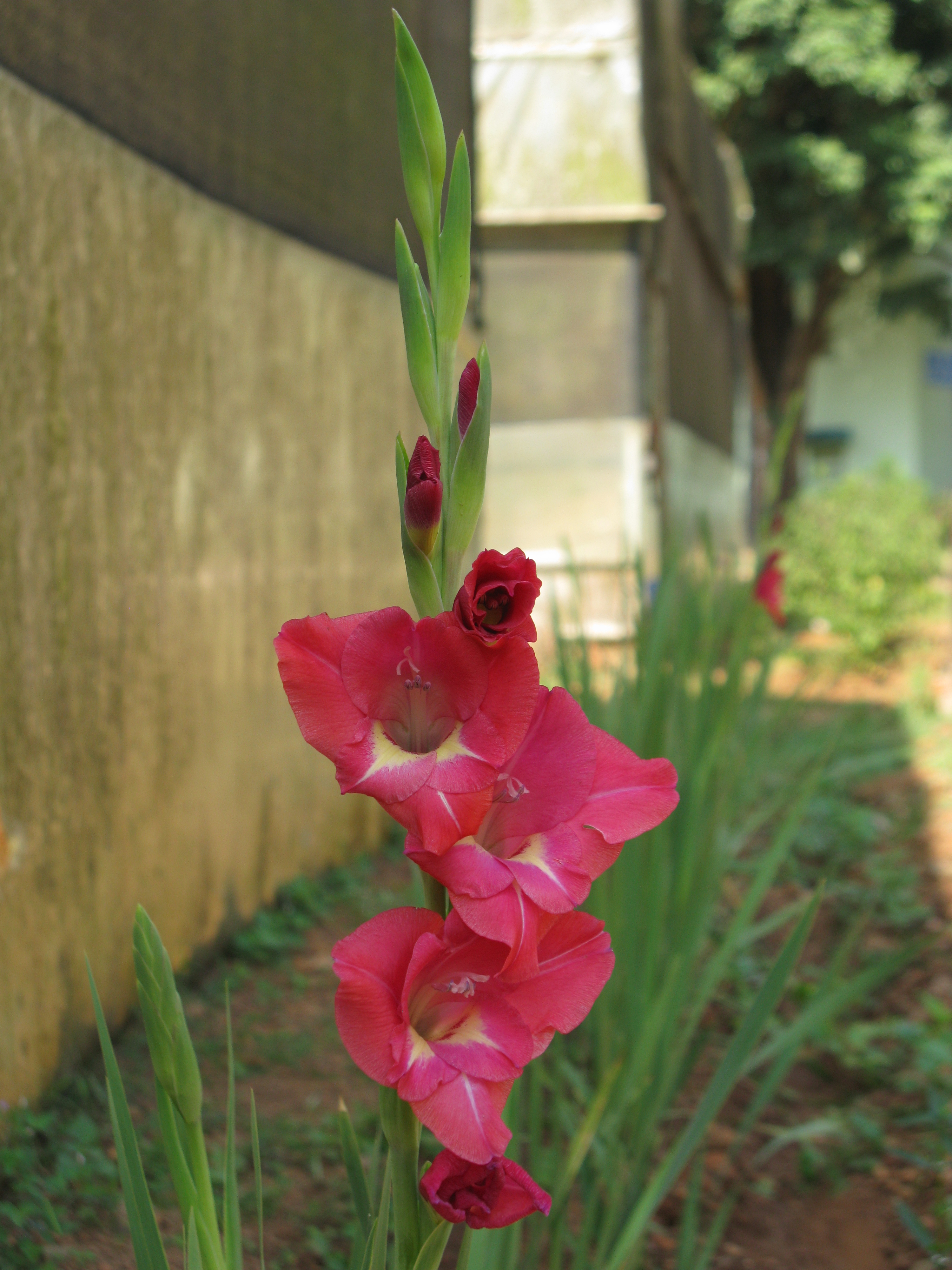

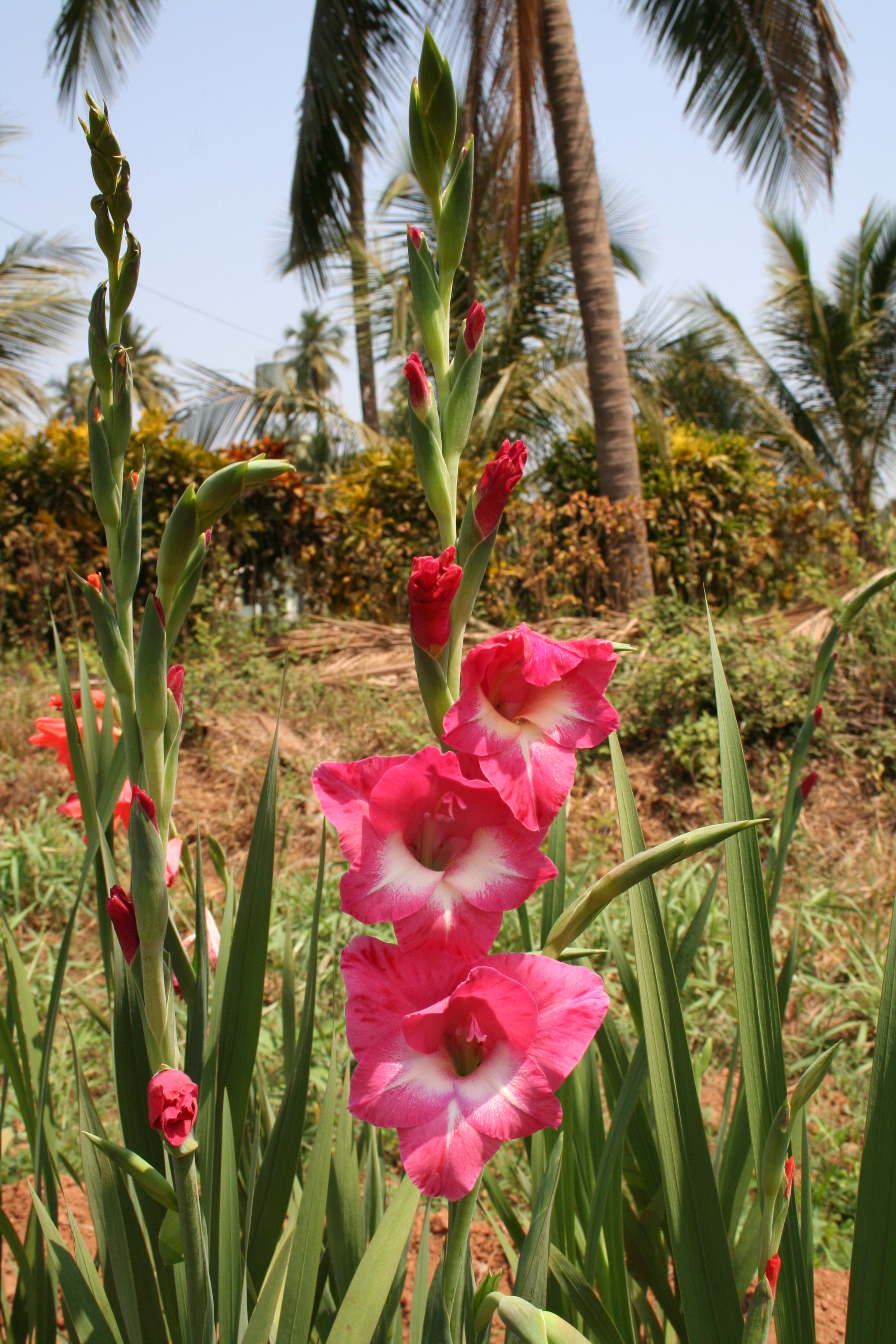
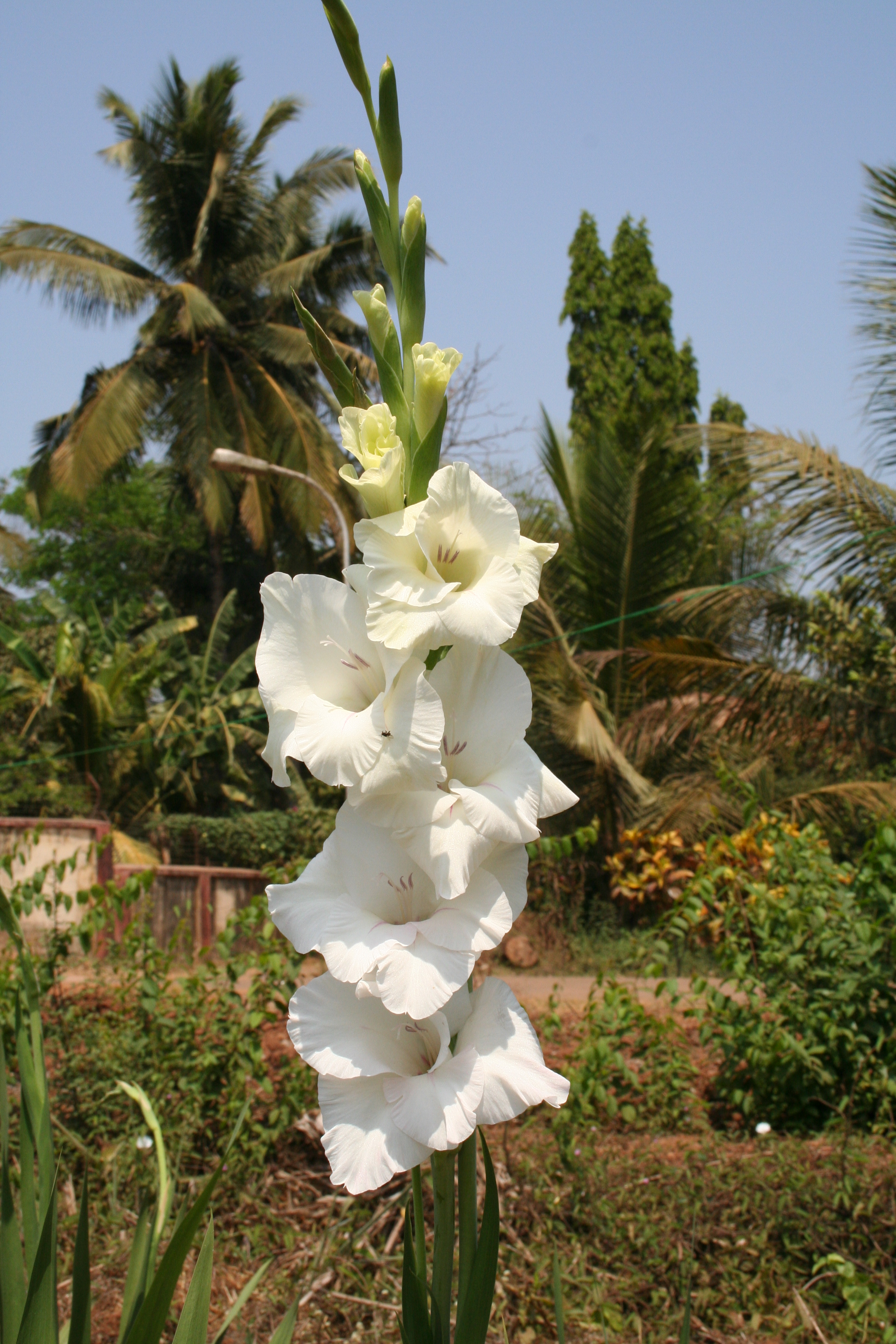
Growth and yield of gladiolus were found better when manure was applied in furrows rather than whole area. When the field is ready for planting, open the furrows to a depth of 15 cm, apply mixture of fertilizers and manure in furrows and mix them with soil. Hence, cattle manure/ FYM @ 2t/1000 sq.m can be applied in furrows along with fertilizers at the time of planting rather than applying prior to ploughing of the land. It saves lot of manure and provides ideal environment to plants in the rhizosphere. This practice increases the spike length, number of florets/spike, corm weight, corm size and cormel production as compared to broadcasting. But care should be taken to use the well decomposed manure.
Gladiolus is a water loving plant and needs sufficient moisture in the soil till the harvesting of spikes. Flower bud initiation and spike elongation are the most critical stages in gladiolus. Moisture stress during these stages results in a considerable damage to growth and yield. Water requirement and frequency of irrigation depend on the soil type, weather conditions and stage of the crop. Lateritic soils need more number of irrigations compared to sandy loam soils. Irrigation is not required in rainy season unless there is a dry spell. In lateritic soils, irrigation should be given once in a week during winter and twice in a week during summer whereas in sandy loam soils once in a week during summer and once in a week or 10 days during winter. Normally, irrigation can be cut down after the harvest of spikes and withheld completely once leaves start yellowing. If the soil is hard, a light irrigation may be given to facilitate the lifting of corms from the soil. Irrigate the crop once in 10 days when it is grown under partial shade of coconut gardens during summer season. It can tolerate high summer temperature and comes up well if sufficient moisture is maintained in the soil during the crop period. So, the success of the crop in summer is mainly dependant on the irrigation.
Weeds compete with crops for water and nutrients and also host insect pests. Gladiolus is a shallow rooted crop which can easily succumb to weeds. If the weeding is delayed or neglected, weeds take over the crop and pose serious problem for growth and yield of gladiolus. Warm and humid conditions prevalent in the state encourage weed growth. Therefore, field must be kept weed free till the flowering/harvesting of spikes and the frequency of weeding mainly depends on the intensity of weed growth. Normally two or three weedings with a gap of 20-30 days are required during the crop period. Weeding can be done either manually using kurphi/hand hoe or by using herbicides. If there is a labour problem, herbicides like glyphosate/grammoxone @0.6 lt/1000sq.m can be applied to the soil prior to the planting of corms. Application of herbicides cannot be taken up in standing crop as they injure plants and cause abnormalities in growth.
Aphids (Aphis gossypi, Aphis craccivora): Aphids suck the sap from tender parts of the plant and the infected plants become weak and get deformed. They excrete honey dew which attracts sooty mould and ants. Incidence of aphids is commonly seen during February and March. It can be controlled by spraying of Malathion 0.1% or Rogor 0.1% at fortnightly interval.
Thrips (Taeniothrips simplex): This is a major pest in gladiolus and causes serious damage to the crop. Yellow nymphs and black adults damage leaves and spikes by rasping tissue and sucking the sap. Affected leaves and spikes develop silver coloured streaks which later turn brown, get deformed and dry if the damage is severe. It also attacks corms in storage and infected corms become sticky, shrivel and produce weak plants when planted. It can be controlled by weekly spraying of Rogor 0.2%. or Malathion 0.1%.
Cut worms (Agrostis segetum): Incidence of cut worms is normally observed in the first month of crop. Eggs of moth are seen near the ground level on plant parts. Larvae feed on emerging shoots and cut the plants at the ground level during night. Sometimes they damage underground corms and developing spikes. Spraying of Methyl Parathion 0.05% or Quinolphos 0.05% at fortnight interval provides protection.
Leaf eating caterpillar (Spodoptera litura): Egg masses covered with hair are seen on under surface of the leaves. Early instar larvae feed on lower surface of leaves by scraping while mature larvae eat leaves voraciously during night time. Skelitenization of leaves is the main symptom. Spraying of Quinolphos 0.05% or Chlorpyriphos 0.05% or Carboryl 0.1% at 10 days interval controls the incidence effectively. Neem oil 1% or neem kernel extract 4% checks damage caused by early instar larvae.
Mealy bug: Both nymphs and adults attack corms by sucking sap causing shriveling and drying of affected corms in severe cases. Incidence of mealy bugs starts in the field during dry conditions and then it is carried to the storage. Movement of ants on plants is the sign of mealybug infestation. Methyl Parathion 0.04% or Di Methoate 0.04% or Acephate 0.1% at fortnight interval can be applied to effectively control mealy bug.
Borer (Heliothis armigera): Larvae feed on leaves and unopened buds. Spraying of Thiodon 0.5-0.8%, Endosulphon 0.07% or Methyl Parathion 0.05% or Ekalux 0.5-0.8% at fortnight interval can control the pest. Neem kernel extract 4% or neem oil 1% can also control the pest.
Wilt (Fusarium oxysporium f.sp.gladioli): Wilt is a major fungal disease in gladiolus. It is soil borne and spread through corms from season to season. High temperature, high level of nitrogen, anaerobic condition and accumulation of carbon dioxide (CO2) favour the fungus. Yellowing of older leaves, browning of vascular tissue and wilting of whole plant are the symptoms of the disease. Roots cannot absorb nutrients and water due to damage of vascular tissues. Soil solarization is reported to give good results but it is laborious and not practical in large areas. The best way to control the wilt is to plant healthy corms and follow crop rotation. Farmers should avoid the use of infected/sick soils for cultivation. Treat corms in hot water (38-400 C) containing 2.5g each of Benlate and Captan for 30 minutes for effective management of wilt.
Corm rot: Corm rot is a common problem caused by group of fungi namely Fusarium, Curvularia, Stromatinia and Pencillium spps. It causes heavy loss particularly during storage. Anaerobic conditions, storage in air tight rooms and more humidity favour the infection. Black, brown, greenish or yellowish mouldy growth on corms is seen during the storage. Under poor air circulation the corms may rot and emit foul smell. Hot water treatment (38-400 C) containing 2.5g each of Benlate and Captan for 30 minutes has been quite effective. Damage to corms at the time of lifting, improper curing and dampness in storage should be avoided.
Curvularia blight: It is caused by many fungi but the most important are Curvularia trifolii and Curvularia ergrostidis. Water soaked oval to elongated brownish spots appear on leaves, sheaths and petals and later they coalesce in advanced stage. The patches turn to brown and finally black. Moist and warm conditions spread the blight very fast. It is effectively controlled by Mancozeb 0.2% spray at 10 days interval.
Spikes of gladiolus are harvested when the first 5-6 flower buds show the colour and the first flower bud is ready to open the next day. Poor opening of flower buds was observed in some varieties when they were harvested at very tight bud stage. Harvesting at bud stage eases transport of spikes without damage to buds. While harvesting spikes, at least four leaves should be retained on the plant to ensure proper development of corms and cormels. Spikes should be harvested with the help of sharp knife or secateur during cool hours of the day to avoid exposure of spikes to hot conditions which accelerates water loss and depletion of stored food due to more respiration. The period of harvesting is different in different varieties and in general it varied from 10 to 15 days. Staggered planting with a gap of 10-15 days and planting of different grade corms of a single variety extend the flowering period. Care should be taken not to crush the stalk of spike at the time of harvesting because the crushed portion releases exudates which promote microbial growth in vase solution. If there is any delay in delivery, spikes should be placed in buckets containing water till they are sent to markets.
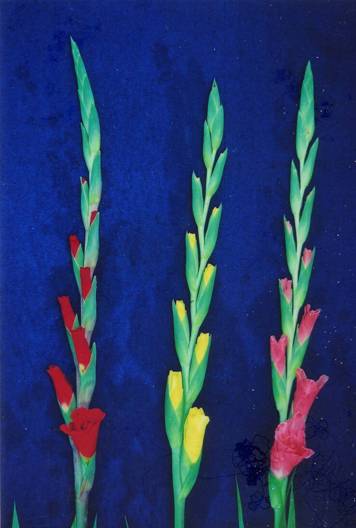
Input availability |
Address/Contact details |
| Seeds |
|
Fertilizers |
|
Pesticides |
|
| Machineries |
|
|
